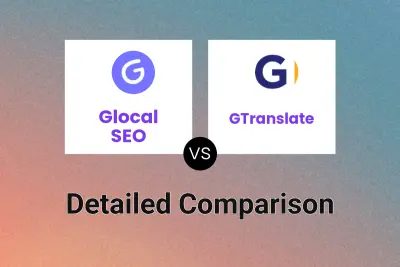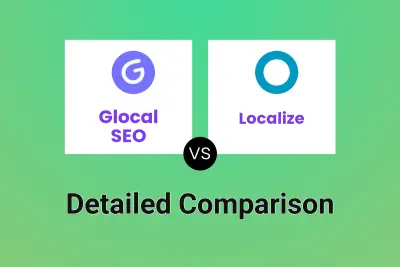 Glocal SEO
VS
Glocal SEO
VS
 GTranslate
GTranslate
Glocal SEO
Glocal SEO offers a streamlined solution for businesses aiming to expand their online presence internationally. The platform simplifies the traditionally complex process of website translation and optimization for global traffic. By leveraging its capabilities, users can make their websites searchable and accessible in up to 109 languages across 100 different countries, significantly broadening potential reach.
The service incorporates features designed to enhance both user experience and search engine visibility. It utilizes a Global Content Delivery Network (CDN) to ensure faster website loading times worldwide and automates the translation and synchronization of metadata, such as titles and descriptions, across all language versions. Glocal SEO adheres to Google guidelines to improve website discoverability and provides SSL encryption for security, ensuring that content updates are synchronized immediately across all international versions.
GTranslate
GTranslate provides a website translation solution designed to make any HTML website multilingual, thereby expanding its reach to a global audience and tapping into new international markets. The service emphasizes the growing importance of catering to non-English speaking internet users, citing statistics that highlight the preference of online shoppers to browse and purchase in their native language. By translating website content, businesses can significantly improve user engagement and potentially increase sales from international visitors.
The platform utilizes machine translation technologies, including neural translations in its paid versions for higher accuracy, particularly when translating to and from English. It offers features designed for ease of use and SEO optimization, such as automatic translation upon installation, search engine indexing of translated pages, and unique URLs for each language version. GTranslate handles seamless updates, ensuring users always have access to the latest service capabilities without needing manual intervention.
Pricing
Glocal SEO Pricing
Glocal SEO offers Paid pricing with plans starting from $25 per month .
GTranslate Pricing
GTranslate offers Freemium pricing with plans starting from $10 per month .
Features
Glocal SEO
- Automatic Translation: Translates website content into 109 popular global languages.
- Global CDN: Improves website loading speed for international users through a global network.
- Metadata Automation: Automatically translates and synchronizes meta tags and descriptions across language versions.
- Immediate Synchronization: Ensures content updates are reflected instantly across all language and country versions.
- Search Engine Indexing Assistance: Helps websites get indexed by search networks around the world.
- Security: Provides SSL encryption for the subdomains created.
- Search Engine Friendly: Follows Google guidelines to enhance website visibility.
GTranslate
- Search Engine Indexing: Allows search engines to index translated pages, improving visibility in different languages.
- Search Engine Friendly URLs: Creates separate, indexable URLs for each language (e.g., fr.domain.com or domain.com/fr).
- Machine Translation: Instantly translates website content using Google and Bing engines (Free version uses statistical, paid versions use neural).
- Translation Editing: Provides an inline editor to manually refine machine translations directly on the website.
- Usage Statistics: Offers a dashboard to monitor translation traffic and the number of translated words/pages.
- Language Hosting: Option to host translated versions on language-specific domains (e.g., domain.fr) for better local SEO.
- URL Translation: Translates website URLs (slugs) for enhanced multilingual SEO.
- Seamless Updates: Automatically updates the service without requiring user intervention.
- Translation Delivery Network (TDN): Cloud-based proxy service that hosts translated versions without needing server changes.
Use Cases
Glocal SEO Use Cases
- Expanding website reach to international markets.
- Automating the translation of website content into multiple languages.
- Optimizing website metadata for diverse global search engines.
- Improving website loading speed for international visitors.
- Managing multilingual website versions efficiently.
- Increasing website visibility and traffic from different countries.
- Localizing websites for specific regions or languages without manual effort.
GTranslate Use Cases
- Making a business website accessible to international customers.
- Expanding e-commerce sales to global markets.
- Improving multilingual SEO performance for websites.
- Providing localized content for diverse audiences.
- Translating blogs and informational websites for broader readership.
FAQs
Glocal SEO FAQs
-
How does the no-code installation work for a domain?
You register on the site, pay for the desired monthly plan, add your website URL to your account, and choose the languages you want your site translated into. Glocal handles the process from there. -
What are local domains and why are they important?
Local domains are country or city code top-level domains (e.g., .FR for France). They signal local relevance to search engines and users. Glocal provides local domains for your website as part of its service. -
What is translation localisation in Glocal?
Glocal uses AI to translate website pages into up to 109 languages quickly (with low latency), caches the translations, and performs necessary optimization steps after connecting to the platform. -
Why is multilingual SEO important?
Multilingual SEO is crucial for reaching a global audience, expanding market reach, and improving user engagement across different language speakers. -
How does Glocal handle meta tags for different language versions?
Glocal automatically transfers and translates meta tags and descriptions for all generated language versions, using appropriate tags (like OGP, Schema.org) to ensure the website is highlighted correctly by local search engines.
GTranslate FAQs
-
Which websites are supported?
All HTML websites are supported, regardless of the programming language or web server used. -
What is the quality of translation?
The free version uses statistical machine translations. Paid versions use more accurate neural machine translations (rated 8.3/10 compared to human translator average of 8.5/10 for Spanish to English). Manual editing is available in paid versions to refine translations. -
How does the free version differ from the paid versions?
The free version provides a language selector widget with automatic Javascript-based translation; URLs don't change, and translations aren't stored or indexed by search engines. Paid versions use a Translation Delivery Network (TDN), hosting translated versions on separate URLs/domains, enabling search engine indexing and offering features like translation editing and URL translation. -
What is a Translation Delivery Network (TDN)?
TDN is a cloud-based translation proxy that mirrors your website in different languages. GTranslate hosts the translated versions, and visits are proxied through their network to your original site, enabling multilingual capabilities without server changes. -
Do I need to pay for Google Translate API key usage?
No, GTranslate provides the automatic translations for free as part of their service.
Uptime Monitor
Uptime Monitor
Average Uptime
5.8%
Average Response Time
92.83 ms
Last 30 Days
Uptime Monitor
Average Uptime
99.86%
Average Response Time
95.53 ms
Last 30 Days
Glocal SEO
GTranslate
More Comparisons:
Didn't find tool you were looking for?


